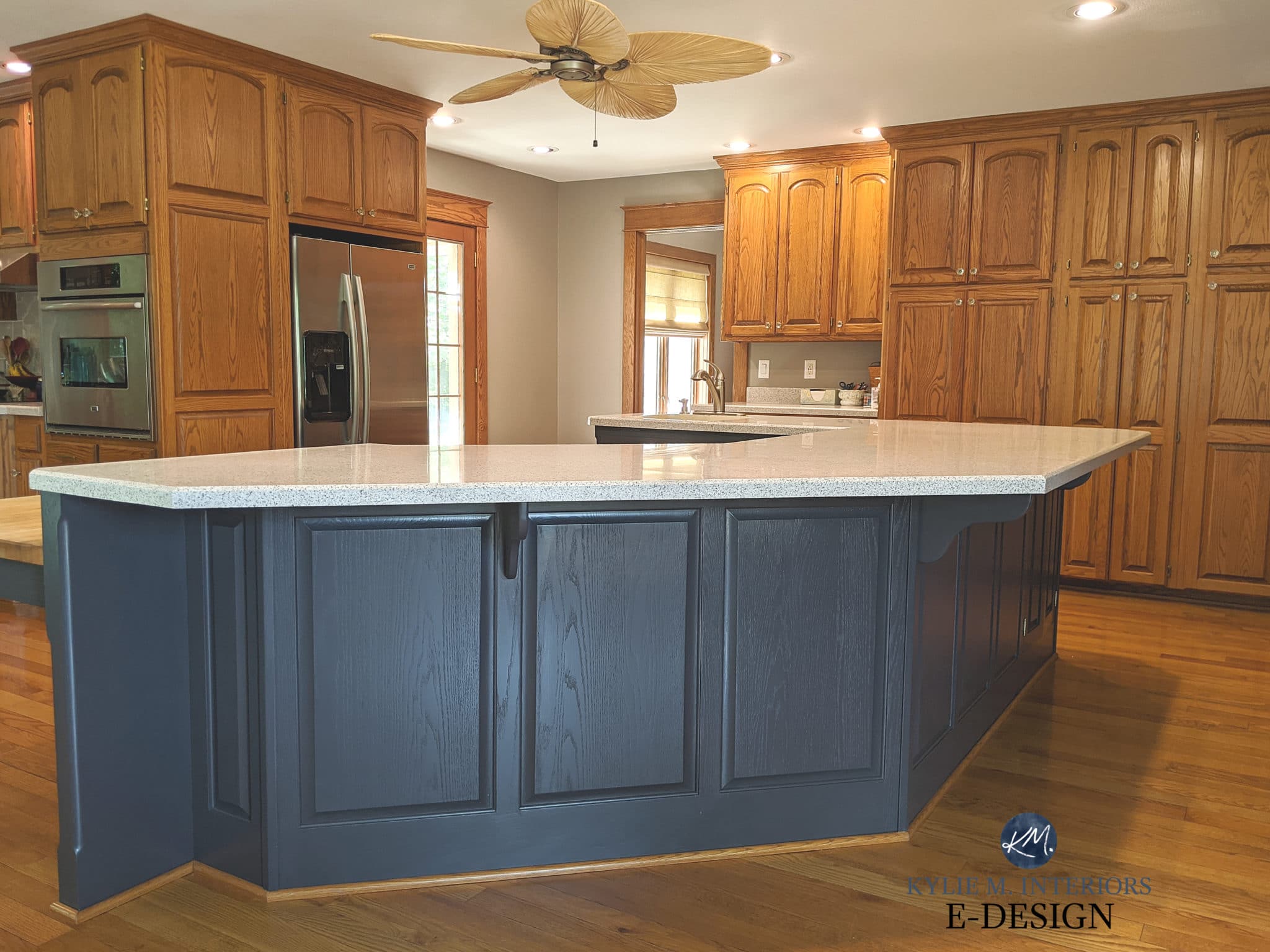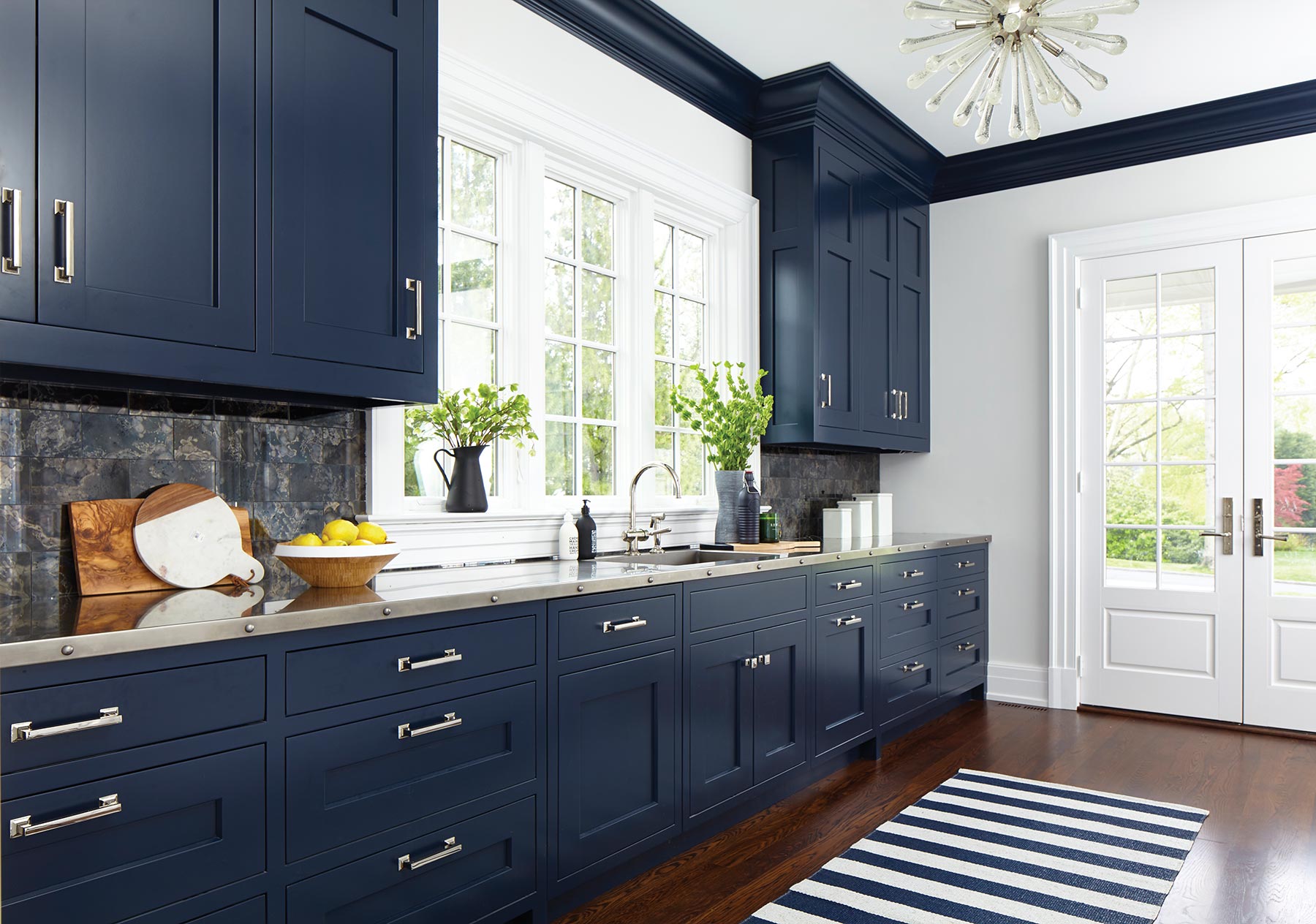Navy Blue Cabinet Paint: Navy Blue Paint For Cabinets

Choosing the right shade of navy blue for your kitchen cabinets can significantly impact the overall aesthetic and feel of the space. The depth and undertones of the color, combined with the lighting conditions, will determine the final visual effect. This section delves into the nuances of navy blue cabinet paint, exploring various shades, their undertones, and the psychological impact they create.
Navy Blue Cabinet Paint Shades and Undertones
The selection of navy blue paint for kitchen cabinets offers a wide spectrum of possibilities, each possessing unique undertones that subtly alter the overall appearance. These undertones, often subtle, can dramatically change how the color interacts with light and the overall mood of the room. The following table organizes several popular shades, their undertones, light reflection properties, and suggested room styles.
| Shade Name | Undertones | Light Reflection | Suggested Room Styles |
|---|---|---|---|
| Midnight Navy | Deep blue with hints of black | Low; absorbs significant light | Traditional, dramatic, modern minimalist (with strategic lighting) |
| Hale Navy | Classic navy, slightly cool | Moderate; reflects a balanced amount of light | Transitional, coastal, farmhouse |
| Naval | Blue-gray, slightly muted | Moderate; reflects a balanced amount of light | Contemporary, Scandinavian, eclectic |
| Deep Ocean | Green-blue, slightly more vibrant | Moderate to High; reflects a good amount of light | Coastal, nautical, beachy |
| Twilight Blue | Purple-blue, sophisticated | Moderate; reflects a balanced amount of light | Glamorous, elegant, modern |
Lighting Conditions and Perceived Color, Navy blue paint for cabinets
Lighting significantly influences the perceived color of navy blue cabinet paint. Different light sources cast varied hues, impacting the final visual effect.
Navy blue paint for cabinets – The following points illustrate the impact of various lighting conditions:
- Natural Light (Sunlight): Sunlight can brighten navy blue, making it appear less saturated and more vibrant, especially during the day. The color may appear slightly different throughout the day depending on the angle and intensity of the sun.
- Incandescent Lighting: Incandescent bulbs tend to cast a warmer, yellowish light, which can make navy blue appear slightly richer and deeper, potentially accentuating any underlying red or brown undertones.
- Fluorescent Lighting: Fluorescent lights produce a cooler, whiter light. This can make navy blue appear cooler and potentially more gray, washing out some of the vibrancy.
- LED Lighting: LED lighting offers a wide range of color temperatures. Cooler LEDs will have a similar effect to fluorescent lights, while warmer LEDs will have a similar effect to incandescent lights. The specific color rendering index (CRI) of the LED also plays a role in how accurately the color is represented.
Psychological Impact of Navy Blue Shades
Different shades of navy blue evoke distinct emotional responses, influencing the overall atmosphere of the kitchen. Lighter shades tend to create a more open and airy feeling, while darker shades create a more dramatic and intimate environment.
The following points compare the feelings evoked by lighter versus darker shades of navy blue:
- Lighter Shades: Lighter navy blues, such as those with gray or green undertones, create a sense of calmness, spaciousness, and serenity. They can make a kitchen feel more inviting and less overwhelming.
- Darker Shades: Darker navy blues, such as midnight or deep ocean shades, create a feeling of sophistication, drama, and luxury. They can make a kitchen feel more intimate and cozy, but in smaller spaces, they might feel more enclosed if not properly balanced with lighting and other design elements.
Painting Techniques & Preparation for Navy Blue Cabinets

Transforming your kitchen cabinets with a fresh coat of navy blue paint can dramatically update the space. However, achieving a professional-looking finish requires meticulous preparation and the right painting techniques. This section details the essential steps involved in preparing your cabinets and applying the paint for a flawless result.
Cabinet Preparation
Proper preparation is paramount for a durable and aesthetically pleasing paint job. Overlooking this crucial step can lead to peeling, chipping, and an uneven finish. The following steps ensure your cabinets are ready for the transformation.
- Cleaning: Begin by thoroughly cleaning the cabinets to remove grease, grime, and any existing finishes. Use a degreasing cleaner, warm water, and a soft cloth or sponge. Pay close attention to areas prone to buildup, such as handles, knobs, and hinges. Rinse thoroughly and allow to dry completely.
- Sanding: Once dry, lightly sand the cabinet surfaces using fine-grit sandpaper (180-220 grit). This step creates a slightly rough surface, improving paint adhesion. Focus on smoothing any imperfections and removing any remaining glossy residue. Wipe down the cabinets with a tack cloth to remove sanding dust.
- Priming: Applying a high-quality primer is essential, especially when painting over dark colors or previously painted surfaces. A good primer will seal the wood, prevent bleed-through, and provide a smooth base for the navy blue paint. Apply the primer evenly using a brush, roller, or sprayer, following the manufacturer’s instructions. Allow the primer to dry completely before proceeding to the next step.
Painting Techniques Comparison
Choosing the right painting technique significantly impacts the final finish. Each method offers advantages and disadvantages, influencing the speed, smoothness, and overall quality of the paint job.
| Painting Technique | Advantages | Disadvantages |
|---|---|---|
| Brush | Precise control, ideal for detailed work (corners, edges), good for smaller projects. | More time-consuming, prone to brushstrokes if not applied carefully, may leave a textured finish. |
| Roller | Faster coverage than brushing, suitable for large, flat surfaces, relatively smooth finish. | May leave roller marks if not used properly, less precise control than a brush, difficult to reach tight corners. |
| Sprayer | Fastest application method, very smooth finish, ideal for large projects, excellent for even coverage. | Requires more setup and cleanup, potential for overspray, requires safety precautions (mask, ventilation). |
Visual Guide to Paint Application
The accompanying visual guide (described below) illustrates the optimal techniques for painting cabinet doors and frames. The image would show a step-by-step process, focusing on consistent, thin coats.
The visual guide depicts a cabinet door and frame. The first panel shows the even application of paint to a cabinet door using long, smooth strokes in one direction, following the grain of the wood. The second panel demonstrates the correct technique for painting the frame, using a small brush for precise application in corners and edges. The third panel highlights the importance of applying thin, even coats, allowing each coat to dry completely before applying the next. This avoids drips and ensures a smooth, even finish. The fourth panel emphasizes the importance of feathering out the edges of each stroke to minimize brush marks. The fifth panel shows the final result, a beautifully painted navy blue cabinet door and frame with a smooth, even finish, free of drips and brushstrokes. The guide includes callouts highlighting key techniques and avoiding common mistakes, such as applying too much paint at once or working in overlapping, haphazard strokes.
